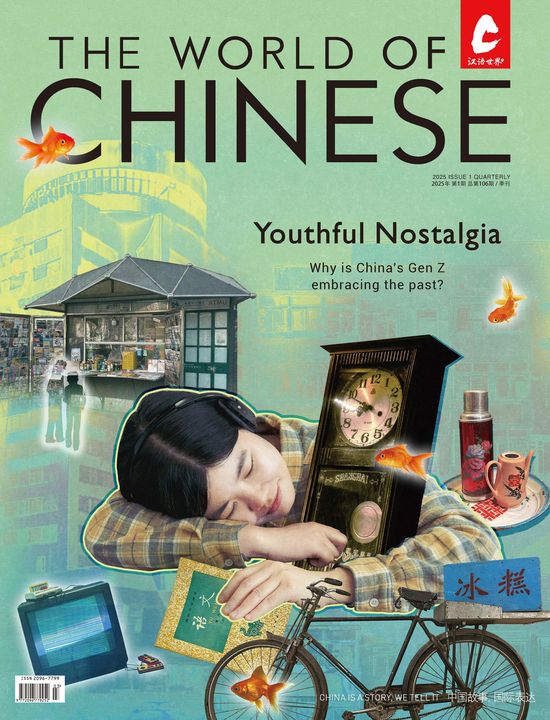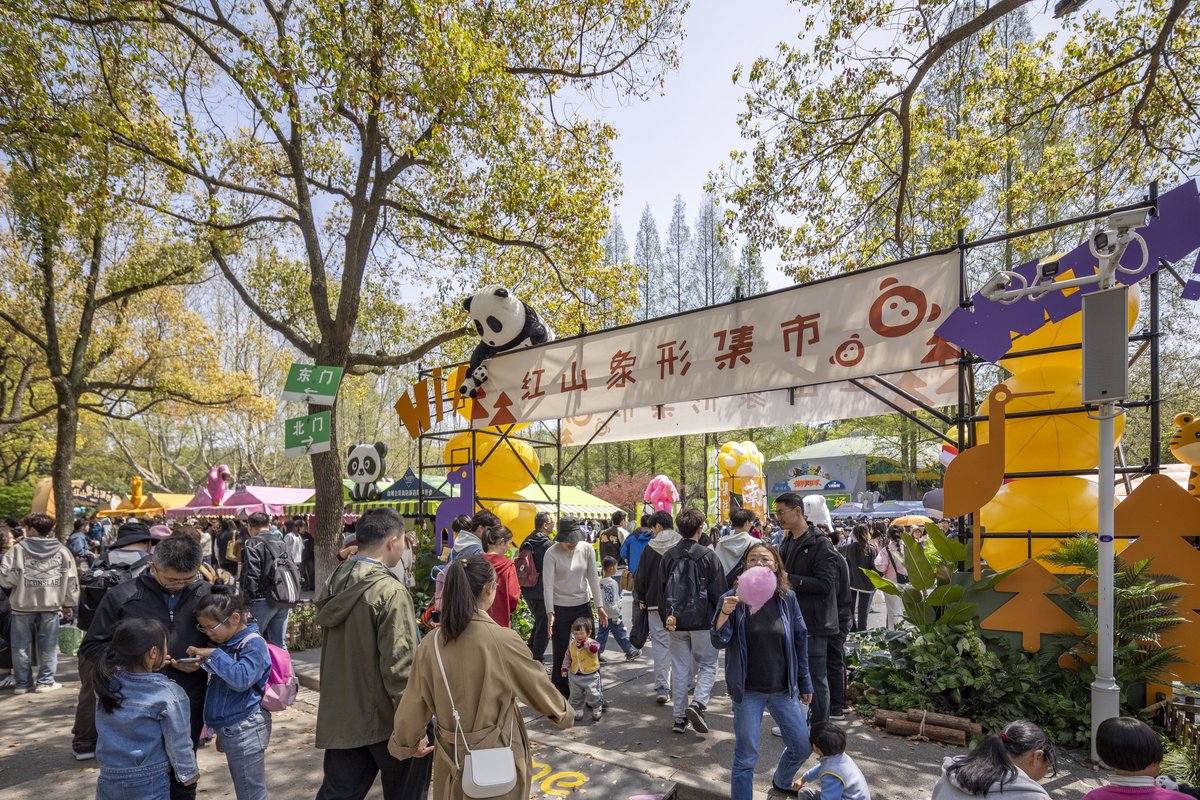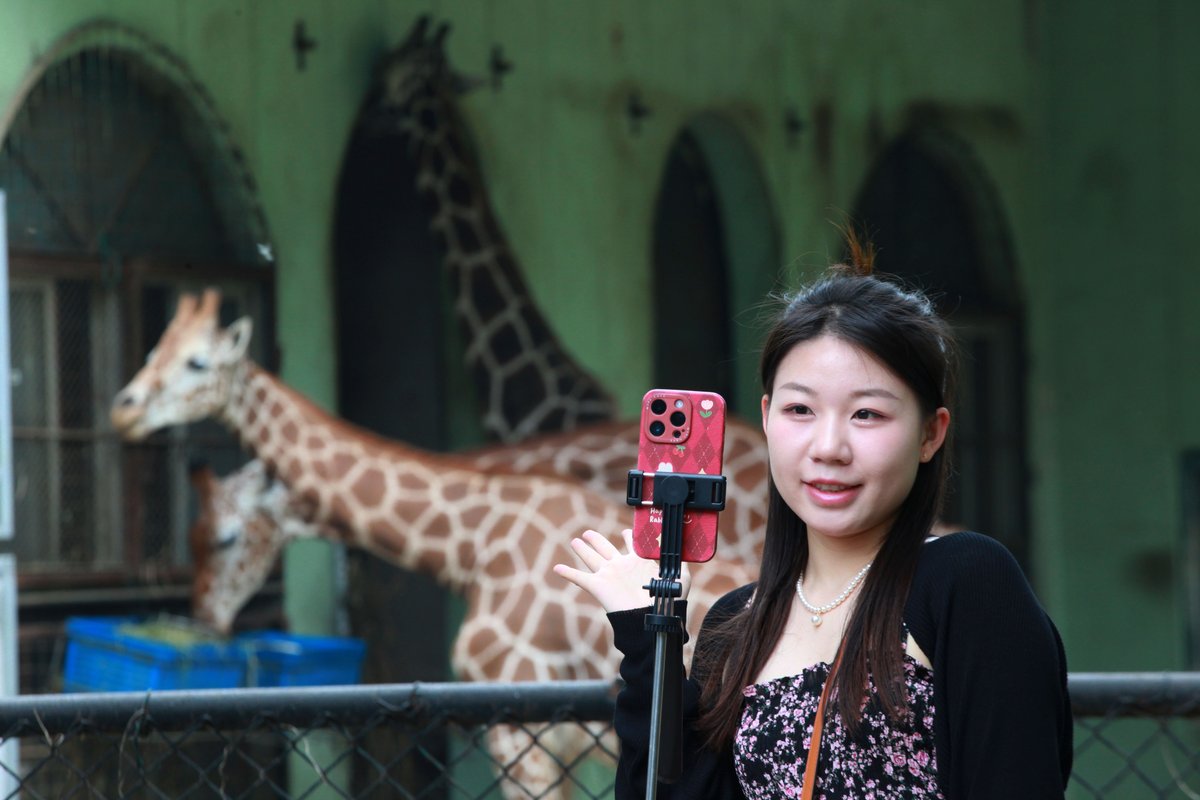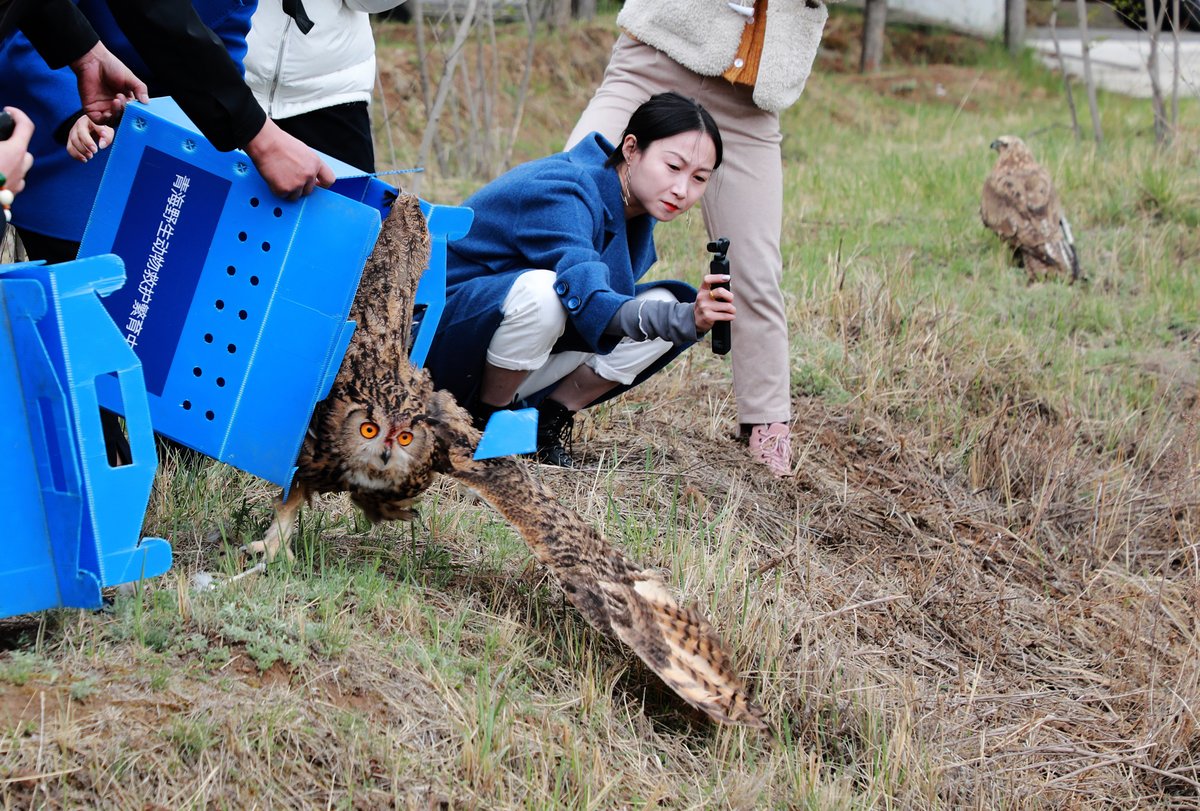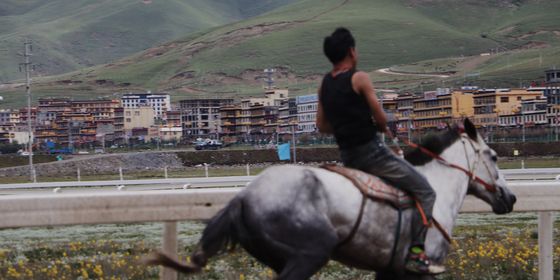As ecologically-minded and media-savvy zoos grow in popularity among young Chinese, experts debate the role that animal parks should play in the urbanized age
At Nanjing’s Hongshan Forest Zoo in China’s eastern Jiangsu province, it’s easy to feel that it’s actually the animals who watch you. The 68-hectare zoo is home to more than 3,000 creatures from 260 species—ranging from local Chinese alligators to African giraffes, Australian koalas, and American jaguars—mostly free to roam in the spacious forested enclosures and show off their natural hunting, mating, and social behaviors…or just nap among the lush plants, rocks, and caves.
Lucky visitors can revel in the gibbons’ famous “morning songs” or watch on anxiously as the meerkats fight for a mate, while those who miss out still have the chance to catch these spectacles via the zoo’s daily livestreams, set up by its media-savvy management team. The livestream has won the zoo millions of fans online and helped entrance tickets sell out during busy periods like public holidays. Its animal-centered approach to zookeeping and conservation, still an anomaly in China even as interest in zoos, nature, and environmental protection surges among urbanites, has led its proponents to hail Hongshan as “China’s best zoo.”
As of 2021, China had about 300 zoos and animal parks, accounting for one-fifth of the world’s total. Around half of these emerged before the 1980s, as scientific research centers and attractions for the public. In the 1990s, many urban public zoos began moving into bigger locations in the suburbs, where they were backed by massive private ventures like the Chimelong Safari Park and Chimelong Ocean Kingdom, built by the Guangdong culture and tourism company of the same name. Zoos have since become major tourist destinations, attracting gaggles of children on school trips, young couples on dates, and families in their free time. China’s leading travel services platform Ctrip reported that ticket sales for zoos during the three-day Qingming Festival holiday in April this year saw a six-fold increase year on year.
While the interest in zoos continues to grow in China, the global discourse around the oftentimes cruel and unnatural conditions of animal enclosures is building momentum. “Globally, zoos are on the decline,” says Zhou Jinfeng, secretary-general of the NGO China Biodiversity Conservation and Green Development Foundation (CBCGDF). He cites two high-profile examples: the 2022 closure of the 186-year-old Bristol Zoo in the UK and recent layoffs at Memphis Zoo in the US, where the reportedly poor conditions of its panda enclosure caused a public uproar in China in 2023.
Read more about animal welfare in China:
- My Years as a Wildlife Rescue Worker
- A Woman’s Battle Against Illegal Animal Performances in China
- Why Animal Abuse is Rife in China’s Pet Industry?
While the World Association of Zoos and Aquariums (WAZA)—which Chimelong joined in 2019 as the sole organization from the Chinese mainland—lists conservation, scientific research, and nature education alongside entertainment as equal functions of the modern zoo, animal lovers and experts in China alike are torn as to what function zoos serve in the modern, urbanized society.
Changing habitats
Fang, a 30-year-old Nanjing resident, referred to here only by her surname, recalls visiting Hongshan when she was a child. Back then, she says zoos were typically places where parents took young kids to feed the animals and watch animal performances. “Step by step, I saw it change into what it is now…shifting toward animal conservation and wildlife rescue, or toward providing educational and science programs for children,” she says.
In multiple media interviews, Hongshan’s director, Shen Zhijun, who joined the zoo in 2008 with nearly a decade of experience in forestry, has said that he felt sorry for the animals who lived “boring, helpless, and hopeless” lives in steel cages and on concrete floors typical of Chinese zoo enclosures built between the 1950s and ’80s. He recalled seeing one wolf pacing back and forth in a narrow cage less than 10 square meters in size, exhibiting the kind of aimless, repetitive movements that stressed animals can develop in captivity and which zoologists call “stereotypic behaviors.”
In 2011, Hongshan became the first zoo in the Chinese mainland to stop staging animal performances, and restricted tourists from feeding animals in 2014. “Many people couldn’t understand [our move] at that time, believing it would cause our losing ‘friends [like peers and tourists].’ But our standpoint is clear: Good zoos should not be places for seeking novelty and entertainment, but bases for people to learn about ecology in a lively way,” he told the state media Economic Daily this August.
Due to budgetary constraints, Hongshan’s upgrades were small at first, switching concrete and steel enclosures for those with more vegetation, bodies of water, and other elements that the animals would enjoy in their natural habitats. In 2018, they opened the Asian Primate House, offering its gibbon and golden snub-nosed monkeys the freedom to travel between a range of environments with artificial tropical, subtropical, and extratropical climates. Its Feline in China exhibit, opened in 2021, was featured by ZooLex, a global zoo design NGO who publishes an authoritative index of the top enclosures in the world.
Despite these improvements, Hongshan’s success is hard to replicate across China, where zoos fall under a complicated web of state and private ownership. A lack of funding and professionalism are also recurring problems: Last September, Chinese media reported that Dongshan Park in Dalian, Liaoning province, had not paid its zookeepers in six months and was running low on animal feed (the local government later stepped in to offer extra funding). In 2015, the 55-year-old Linfen Zoo in Shanxi province said its visitor numbers had dropped from 10,000 per day in the 1990s to just 300 on its busiest days, with director Fan Liming admitting to local journalists they had “no certified veterinarians, nutritionists, or maintenance technicians,” and that the animals’ living conditions were bad, adding, “Operations are extremely difficult when tickets are priced at 5 yuan.”
Out west on the Qinghai-Xizang Plateau, home to the endangered snow leopard and Pallas cat, the 900-hectare Xining Wildlife Park, which also acts as an animal rescue center, has tried to improve its animals’ welfare with various enrichment measures. These have included making an artificial hill for blue sheep to climb, suspending iron hoops, tires, and branches for ring-tailed lemurs to play with, and planting grass nests for chukars to take shelter from sunshine and rain. However, in 2021, director Qi Xinzhang told Perpetual Light Studio, a public WeChat account under Sohu News, that they severely lacked the “venue construction and professional expertise” to follow Hongshan’s model.
Since the 2000s, many city zoos have relocated to the suburbs to make room for urban development, but the herald of larger venues has not put an end to traditional designs, mostly due to a lack of professional knowledge. In Shanxi province, a 3-billion-yuan renovation doubled the size of its Taiyuan Zoo to over 130 hectares. However, the zoo’s largest single building, a 7,000-square-meter elephant house, still features a bare indoor court defined only by cement floors and concrete pillars. Videos taken of its occupants routinely show them exhibiting stereotypic behaviors.
Meanwhile, China’s growing wildlife park sector, featuring more expansive enclosures where visitors can go on safari-like tours, might also mislead the public into believing they are more ecological than they really are. Many still promote commercialized feeding, petting services, and animal performances—now in the name of the presentation of “animals’ behavioral training.” When TWOC visited Beijing Wildlife Park in the suburban Daxing district, the zoo staff advertised the spotted hyena as “the second fiercest animal in Africa,” only to invite tourists to “enjoy the fun of feeding it.” Thousands of users on the social media app Xiaohongshu have called out the zoo for animal cruelty, particularly for keeping a dog in the same enclosure as a lion and two tigers, and claiming they are “siblings” who were nursed by the same canine mother.
When zoos go viral
This July, Fu Lin called her local zoo to offer her services as one of their volunteer “little tour guides,” a position available to those in third grade and above. Having graduated from college years ago, Fu argued, “I am ‘above’ third grade.” Nevertheless, the zoo declined her offer.
“I love zoos,” says the 30-year-old, who teaches art online in a small northern Chinese city. She sees the zoo’s volunteer program—while obviously targeted at young kids—as a stepping stone to veterinary training and, eventually, a career working in a zoo. She’s hardly alone: The conservationist ethos of Chinese zoos like Hongshan, often bolstered by clever social media campaigns and merchandising, has won the favor of young adults and teenagers, who’ve embraced zoos as fashionable leisure destinations.
Chen Xuanqi, a middle school student who runs a zoo-related blog, became interested in zoos after visits during the pandemic, a time when there were limited options for travel and leisure. “I haven’t traveled much, so I’ve never seen any animals in the wild,” Chen tells TWOC. “For an urban-dweller like me, zoos are the best place to learn about animals because you have much better odds of seeing and learning about different species there than in the wild.”
Having visited, on average, one zoo per month for the last four years, some of them repeatedly, Chen has noticed how Chinese zoos—and their visitors—are evolving. “Beneath their trendy appearance, zoos are gradually becoming places for public education, though it’s not always evident,” he says, noting that zoos like Hongshan now feature more biodiversity in their collections, and that many also function as animal rescue centers or conservation centers for endangered species.
However, “Many people still only go see so-called ‘viral’ animals like giant pandas or capybaras...and couldn’t tell, say, an armadillo apart from a pangolin.” Chen believes the public still associates zoos with paid feeding activities. “Zoos need to raise awareness about the [inappropriateness of] feeding, and take the first step by eliminating it.”
Fang, the Nanjing resident, believes zoos can be beneficial, especially when not-for-profit enterprises attract young visitors and educate them about responsible natural stewardship, using ticket and merchandise sales to further improve the animals’ conditions. “I think a major reason young people are attracted to zoos, especially zoos like Hongshan, is because they are like a utopia for perfect equality,” she tells TWOC. “When people enter them, they escape the inequalities of the outside world, such as in the workplace...because a zoo that puts animals first will put humans close to last.”
Similarly, Hongshan’s director, Shen, believes that zoos like Hongshan have become popular because they help young people find “healing.” Pursuing nature and freedom is instinctive for humans, and urban youths want to connect with nature and animals. Modern zoos, described by Shen as “the habitats of wildlife in cities,” offer them a space to find empathy, resonance, and relief from the pressures of studies and life, he noted in an interview with China Youth Daily this February.
Some animal lovers, though, worry that this romanticization of zoos and nature is just another form of anthrocentrism. “I think sometimes people read too much into [animals],” says Zhao Dandan, a mid-30s zoo enthusiast based in Beijing. She cites the example of the capybara, a large species of South American rodent that Chinese internet users have embraced as a mascot due to its seemingly calm, unruffled demeanor. “I like capybaras for what they are, rather than for what feelings people project onto them.”
An end to zoos?
Instead of rebranding zoos as conservation and education centers—and raising money to fund such initiatives—Zhou Jinfeng of the CBCGDF has a more radical proposal: gradually getting rid of zoos, and putting their funds and efforts into preserving and rebuilding natural ecosystems. “For sure, we shouldn’t be building any new zoos, and existing zoos should be making necessary adjustments, such as by rehabilitating animals in the wild,” he says, citing the 2019 release of two beluga whales into the North Atlantic Ocean by Shanghai’s privately-run Changfeng Ocean World as a positive example. “Don’t emphasize scientific education [via zoos] anymore, and don’t add any new animals.”
Hongshan has been dedicated to wildlife rescue and rehabilitation. Doubling as the Jiangsu Provincial Wildlife Rescue Center, the zoo rescues approximately 1,000 injured and stray wild animals each year, around 40 percent of which can recover and be rehabilitated to return to the wild. It has also partnered with organizations in wildlife conservation, such as with Nanjing Forestry University on gene research for the zoo’s chimpanzees, and the NGO Chinese Felid Conservation Alliance on protection and research projects.
With these efforts, Hongshan is making a case for the continued need for zoos in modern society—no longer “simply places to satisfy tourists’ curiosity and pleasure, but more like a ‘Noah’s Ark’ of wildlife genes that conserves species,” director Shen told the Economic Daily. He called zoos a “bridge” between cities and nature, pointing out that they are more accessible as venues for public nature and biodiversity education than remote wilderness reserves. “Zoos allow people to explore ecosystems around the world in just one day,” he said in a public speech in 2022.
Fang, who grew up visiting Hongshan, feels torn between the two positions. “As our country’s wildlife protection laws are still imperfect, the criticisms that [anti-zoo advocates] raise are valid...but I also think zoos are continuing to improve.” She feels that the root of the solution lies in better nature education for the whole of society. “Kids today don’t have any specific classes [on nature], so their knowledge is limited to what they learn from their parents taking them to zoos, and sometimes they learn harmful behaviors like feeding animals or pounding on the glass to get their attention,” she says. “I think the vast majority of people are not malicious, but just ignorant. There is a long way to go for better education.”
State policies now promote the idea of China becoming an “ecological civilization,” a development path emphasizing harmony between humans and nature. The country has strengthened environmental protection education in schools over the last two decades, and Zhou has seen an increase in young people volunteering for his NGO, donating to conservation, and bringing cases of animal or environmental abuse to their attention. “People might criticize me now, but sooner or later, this is the path we will all follow,” he declares. “Places like Beijing Zoo and Hongshan Zoo will all close eventually, but for now, they can show us the way forward.”
